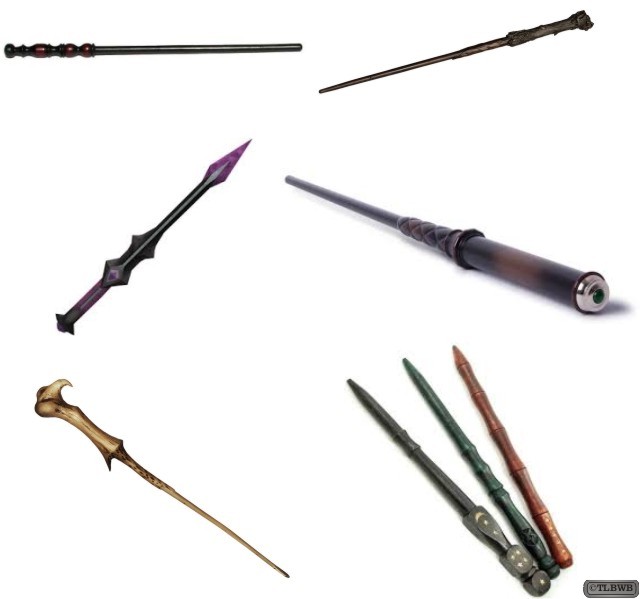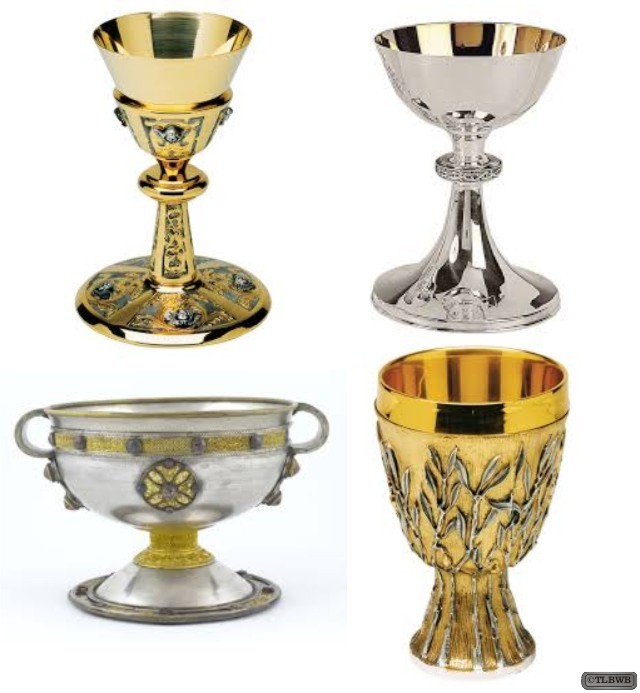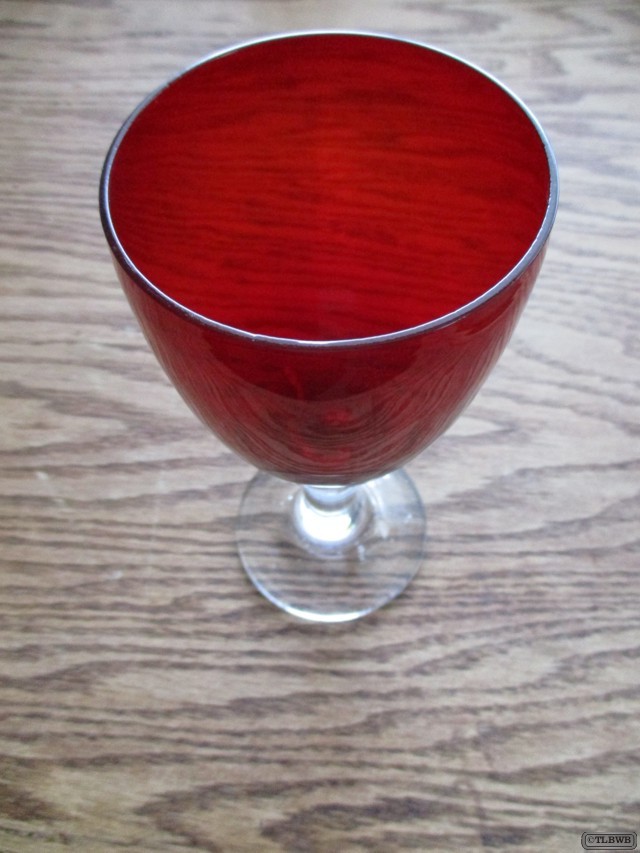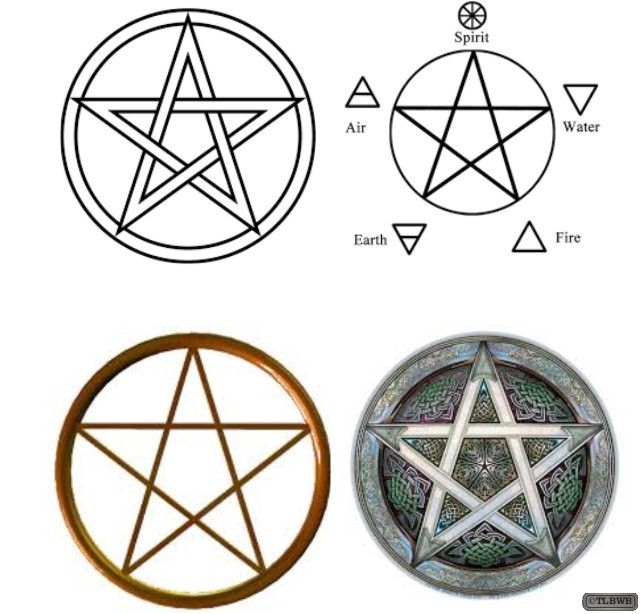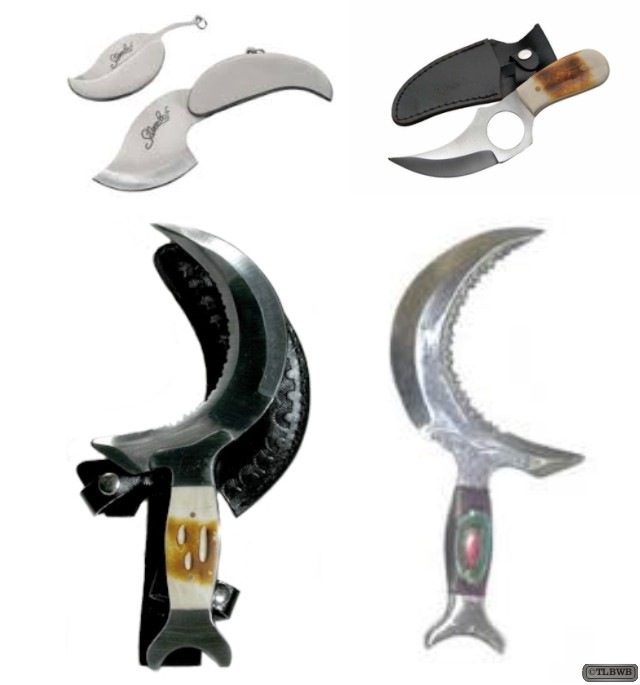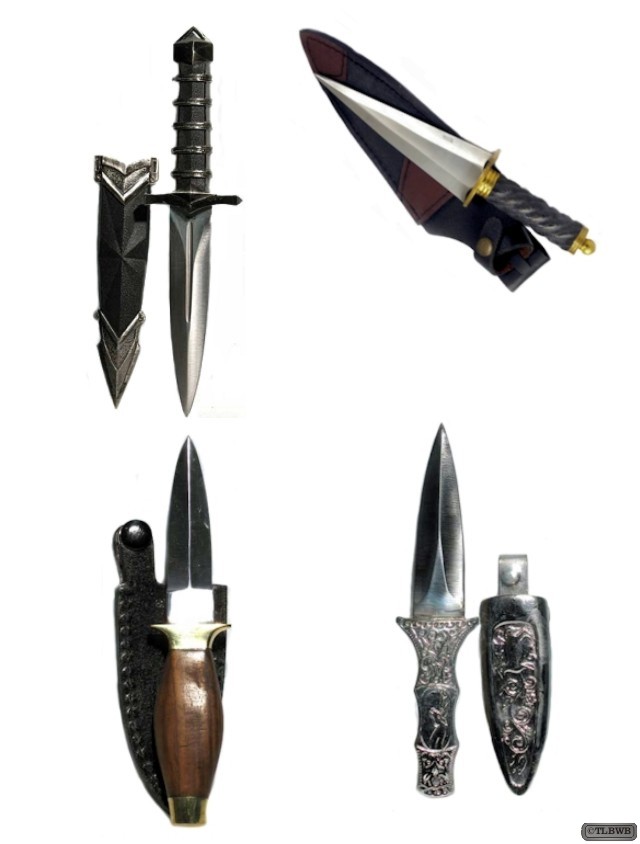LostBeardedWhite
A wand (sometimes magic wand) is a thin, hand-held stick or rod made of wood, stone, ivory, or metals like gold or silver. Generally, in modern language, wands are ceremonial and/or have associations with magic but there have been other uses, all stemming from the original meaning as a synonym of rod and virge, both of which had a similar development. A stick giving length and leverage is perhaps the earliest and simplest of tools. Long versions of the magic wand are usually styled in forms of staves or scepters, often with designs or an orb of a gemstone forged on the top.
Mystical, Occult, and Religious Usage
In Pharaonic Egypt, toilette articles, weapons against possible enemies, amulets against serpents, were also left in the tomb, together with magic texts and a magic wand which enabled the ba (soul) to use them.
In classical Greco-Roman mythology, the god Hermes/Mercury has a special wand called a caduceus.
Six to eight-foot-long staves with metal tips adorning them are carried traditionally in Freemasonry during rituals of the Craft. Ceremonial uses may have several wands for different purposes, such as the Fire Wand and the Lotus Wand in the Hermetic Order of the Golden Dawn. In Zoroastrianism, there is a similar ritual implement called a barsom. In Wicca and Ceremonial magic, practitioners use several magical tools including wands for the channeling of energy-they serve a similar purpose to the athame although the two have their distinct uses. While an athame is generally used to command, a wand is seen as more gentle and is used to invite or encourage. Though traditionally made of wood, they can also consist of metal or crystal. Practitioners usually prune a branch from an Oak, Hazel, or other tree, or may even buy wood from a hardware store, and then carve it and add decorations to personalize it; however, one can also purchase ready-made wands. In Wicca the wand usually represents the element air, or sometimes fire, although contemporary wand makers also create wands for the elements of earth and water as well. The wand is most often used by Neopagans, Wiccans, Shamans and others in rituals, healing and spell casting.
There is some scholarly opinion that the magic wand may have its roots as a symbol of the phallus. It may also have originated as the drumming stick of a shaman, especially in Central Asia and Siberia, as when using it to bang on his drum or point, to perform religious, healing, and magical ceremonies.
The Lost Bearded White Brother
A Chalice (from Latin calix, mug, borrowed from Greek kalyx, shell, husk) is a goblet or footed cup intended to hold a drink. In general religious terms, it is intended for drinking during a ceremony.
The chalice, or goblet, is symbolic for the element of Water. Many Wiccans do not consider it to be a tool, but instead to be a symbol of the Goddess, particularly her womb. The chalice bears many similarities with the Holy Grail, except for its symbolism used in witchcraft. Rather than being the blood of Christ, it is symbolic of the Goddess’ womb. The chalice is often used to hold wine, water, milk, juice and other ritual drinks.
Christian
In Roman Catholicism, Eastern Orthodoxy, Oriental Orthodoxy, Anglicanism, Lutheranism and some other Christian denominations, a chalice is a standing cup used to hold sacramental wine during the Eucharist (also called the Lord’s Supper or Holy Communion). Chalices are often made of precious metal, and they are sometimes richly enamelled and jewelled. The gold goblet was symbolic for family and tradition.
Wicca
In Wicca a chalice, as a feminine principle, is often used in combination with the Athame (ceremonial black-handled knife), as male principle. Combining the two evokes the act of procreation, as a symbol of universal creativity. This is a symbol of the Great Rite in Wiccan rituals. A chalice is also used in the Small Rite.
Neo-Paganism
Some forms of Neo-Paganism make use of chalices in their rituals as well. A chalice may be placed on an altar or on the ground. The chalice may contain wine, whiskey, water, or other liquids.
The Lost Bearded White Brother
A pentacle is an amulet used in magical evocation, generally made of parchment, paper or metal (although it can be of other materials), on which the symbol of a spirit or energy being evoked is drawn. It is often worn around the neck, or placed within the triangle of evocation. Protective symbols may also be included (sometimes on the reverse), a common one being the five-point form of the Seal of Solomon, called a pentacle of Solomon or pentangle of Solomon. Many varieties of pentacle can be found in the grimoires of Solomonic magic; they are also used in some neopagan magical traditions, such as Wicca, alongside other magical tools.
The words pentacle and pentagram (a five-point unicursal star), which traces the etymology through both French and Italian back to Latin, but notes that in Middle French the word “pentacle” was used to refer to any talisman. In an extended use, many magical authors treat them as distinct. In many tarot decks and in some forms of modern witchcraft, pentacles often prominently incorporate a pentagram in their design.
There is a specific differentiation between pentacle and pentagram within Wicca and other neopagan traditions. Namely, a pentacle refers to a pentagram circumscribed by a circle. This form of pentacle is formed upon a disk which may be used either upon an altar or as a sacred space of its own. The pentacle is representative of the Earth in occult usage.
Pentacles, despite the sound of the word, often had no connotation of “five” in the old magical texts, but were, rather, magical talismans inscribed with any symbol or character. When they incorporated star-shaped figures, these were more often hexagrams than pentagrams.
The Pentagram means different things to different people. Some may argue as to what it represents, so if these words do not agree with you, do not get your panties in a knot. So here are several meanings of the pentagram and I am sure there are more that I have not covered.
The Pentagram right side up represents the Divine ruling over the world of matter. Let us not forget that it also represents the elements Spirit, Water, Air, Earth, and Fire as shown below. This is most commonly used pentagram by most people in Witchcraft.
The Lost Bearded White Brother
Wiccan morality is largely expressed in the Wiccan Rede: ‘An’ it harm none, do what ye will’ – old-fashioned language for ‘as long as you aren’t harming anyone, do as you wish’. While this could be interpreted to mean “do no harm at all,” it is usually interpreted as a declaration of the freedom to act, along with the necessity of thinking through and taking responsibility for the consequences of one’s actions.
Another element of Wiccan Morality is expressed in the Law of Threefold Return, which is understood to mean that whatever one does to another person or thing (benevolent or otherwise) returns with triple force. Opinions differ on whether the form taken by the return of harmful actions might include bad reputation, revenge by others, negative emotional states, an uneasy conscience, poor luck, malign magical influences, something resembling the Hindu concept of karma, or some combination of some or all of these, and also on to what extent the number three should be interpreted poetically rather than literally.
Many Wiccans also seek to cultivate a set of eight virtues mentioned in Doreen Valiente’s Charge of the Goddess, these being mirth, reverence, honour, humility, strength, beauty, power and compassion. Describing this witch-cult as “a joyous religion”, she claimed that the two primary festivals that it celebrated were on May Eve and November Eve, although that other dates of religious observation were 1 February and 1 August, the winter and summer solstices, and Easter. She asserted that the “General Meeting of all members of the religion” were known as Sabbaths, while the more private ritual meetings were known as Esbats. At the former, magical rites were performed both for malevolent and benevolent ends. She also asserted that the Sabbath ceremonies involved the witches paying homage to the deity, renewing their “vows of fidelity and obedience” to him, and providing him with accounts of all the magical actions that they have conducted since the previous Sabbath.
The Lost Bearded White Brother
In Wicca the boline is a white-handled ritual knife, one of several magical tools used in Wicca, mainly for the cutting of herbs and inscribing candles.
Unlike the athame, which in most traditions is never used for actual physical cutting, the boline is used for cutting cords and herbs, carving candles, etc. It has a small, straight or crescent-shaped blade with traditionally, a white handle. A Boline is a tool with two purposes, the first is to aid in collecting ingredients. To this end is functions as shears with the additional benefit that it will harvest cobweb without turning it to string. A Boline can be used as a weapon with the same durability as an iron sword, but the damage of a wooden sword. It can be enchanted like an iron sword. The Boline is meant to be put to work and become an active part of your magickal practice.
You may wish to consecrate your boline before you use it for the first time. In many modern Pagan traditions, magical tools are consecrated before use. This achieves a couple of things — one, it purifies the item before it is used to interact with the Divine. Secondly, it removes any negative energies from the tool. This is particularly handy if you aren’t sure of a tool’s past history or who owned it before it came to you. This ritual is a simple one that can be used to consecrate any magical tools, clothing or jewelry, or even the altar itself.
The Lost Bearded White Brother
Athame
An Athame is a ceremonial dagger, with a double-edged blade and usually a black handle. It is the main ritual implement or magical tool among several used in the religion of Wicca, and is also used in various other neopagan witchcraft traditions. A black-handled knife called an arthame appears in certain versions of the Key of Solomon, a grimoire originating in the Middle Ages.
On the other hand, the athame stands as one of the four elemental tools in Wicca; traditionally standing for fire, as does the ritual sword. The other three elemental tools are the wand, the pentacle, and the cup or chalice. These four magical tools correspond to four ‘weapons’ of significance in Celtic myth – the sword, the spear, the shield, and the cauldron (and/or grail). The same four ritual tools also appear in the magical practices of the western hermetic tradition, derived from The Golden Dawn; and they appear in tarot decks as the four card suits: swords, cups, wands, and pentacles. The athame is an individual ritual tool, while the sword is more appropriate as a coven tool, or the personal tool of the high priest or high priestess. There are obvious risks associated with an entire group of people all wielding swords, while confined within a small ritual circle space nine feet in diameter; this safety factor, as well as ease of use, may explain why the emphasis within Wicca is more on each witch’s personal athame, rather than the ritual sword.
An athame can take many forms. It usually has a double-edged blade with a sharp point, and a handle which is often black. The athame’s primary use is to channel and direct psychic energy, generally conceived as etheric fire. The ritual drawing of the boundary of the Magic circle – also known as “casting the circle”. In most traditional covens, the athame is associated with the magical element of fire, so the circle is considered to be cast in etheric fire. When the circle is ritually purified after being cast, that is traditionally done with the remaining three elements – air (incense), water (salt-water), and earth (salt) – because the element of fire has already been imbued into the circle during the casting, by the use of the athame.
The Lost Bearded White Brother
The Rede is the Central Law of Wiccan religion. In short it states: “If it harms none, do what you want.” You may see it phrased in different ways. Some use the old English: “An it harm none, do as thou wilt”. The Rede is seen by both Wiccans and outside observers as very similar to the Golden Rule, a belief that is found in nearly every religion. It should be noted that, while the Golden Rule forbids harm subjectively, the Wiccan Rede forbids harm absolutely. The concept of ethical reciprocity is not explicitly stated, but most Wiccans interpret the Rede to imply the Golden Rule in the belief that the spirit of the Rede is not just to do no harm, but to actively do good for one’s fellow man as well as oneself.
Different sects of Wiccans read “none” differently: some include the self, others include animals or plants, and so forth. The Rede also expressly rejects the concept of sin outside of harm to oneself or to another. The Rede is only a guideline which the individual must interpret to fit each particular situation. Partner to the Rede is the Rule of Three. It states that both the good and the evil that one creates in the world will be returned threefold (in joy or suffering). It is therefore seen as a pragmatic reason for ethical behavior and compliance with the Wiccan Rede.
The Wiccan Rede is a statement that provides the key moral system in the Neopagan religion of Wicca and certain other related Witchcraft-based faiths. A common form of the Rede is An it harm none, do what ye will.
The word “Rede” derives from Middle English, meaning “advice” or “counsel” and being closely related to the German Rat or Norwegian and Swedish råd. “An” is an archaic Middle English conjunction, meaning “if.” “Ye” is an archaic or dialectal form of “you” (nominative plural).
Other variants of the Rede include:
- Eight words the Wiccan Rede fulfill, An it harm none do what ye will.
- An it harm none, do what thou wilt.
- An it harm none, do as thou wilt.
- That it harm none, do as thou wilt.
- Do what you will, so long as it harms none.
The Lost Bearded White Brother
“Wicca” is an Old English word meaning magic user. A male Witch is called a Witch, not a warlock. These days a Wiccan is a person who practices a life-affirming, nature-oriented religion. In general, Wiccans honour Deity in both female and male forms.
In addition, some traditions may encompass other beliefs. Some traditions are practiced by women only and recognize only Goddesses. Others include men and recognize male Gods in addition to Goddesses. Some folk traditions may date back many centuries; others have been in existence for only a few years. The strength of Wicca lies in its diversity. It is a living, growing religious tradition.
The short answer: Witch comes from the Old English Wicce (masculine) or Wicca (feminine) meaning “magician or diviner. The word Witch is not related to Wizard which means a wise man or philosopher.
Some Witches pray (in the popular sense of the word), some don’t. Some Witches regularly meditate on the Deities of their choice; some only invoke Deities to empower a ritual or to work Magic.
As to who or what our Deities are, you will get nearly as many answers as there are Wiccans. The majority opinion seems to be that there is a transcendent Divine, the sum of all that is and that everything partakes of that Divinity. The Moon, the Sea, and the Earth can all be personified as Goddesses, although saying that Wiccans worship the Moon.
We believe that life is essentially good, and creation and destruction are part of natural cycles. Evil is that which causes harm and/or decreases the joy in the world. The source of evil is not any kind of devil or demiurge, but human action. Evil is also subjective: what is good for one may be evil for another and vice versa. For example, a man kills an antelope for food — the antelope’s death is bad to the antelope, but good to the man who must eat to live.
The Lost Bearded White Brother
If you are in a potentially dangerous situation, if you are in an abusive relationship, if somebody threatens you or wants to harm you, if you feel like committing suicide, or are in any situation where you do not know what to do or are fearful of your safety or of the safety of others, please contact your local authorities. Magic is not a solution for urgent problems like these and we cannot help you in any way with those kinds of problems.
Magic cannot be a substitute for professional, legal, medical, financial or psychiatric advice or care. You agree that your spells and their effects are subject to your own interpretation. We cannot be held responsible for any problems, stress or loss of income caused by any persons or event incurred in the process of using any information on sassquatch.org.
The Lost Bearded White Brother
Magic is a way of life for many of us, and more and more people like to learn more about the subject and perform their own spells. Learning magic is a lifelong quest, but everybody can do it. It can help you become a better human being and if you live by its main principles you can make an impact on the universe and make it a better place to live.
If you are interested in following online classes in magic or attending seminars, please fill the form below and let us know about your interests. If there is enough demand we will soon post a series of online classes, and prepare some seminars, and contact you about them.
We also plan to soon put into the market some spell kits that contains the same ingredients we use to cast our spells with complete instructions on how to prepare yourself and do the spell. We will soon also be offering a full line of magical items in our online store.
The Lost Bearded White Brother
